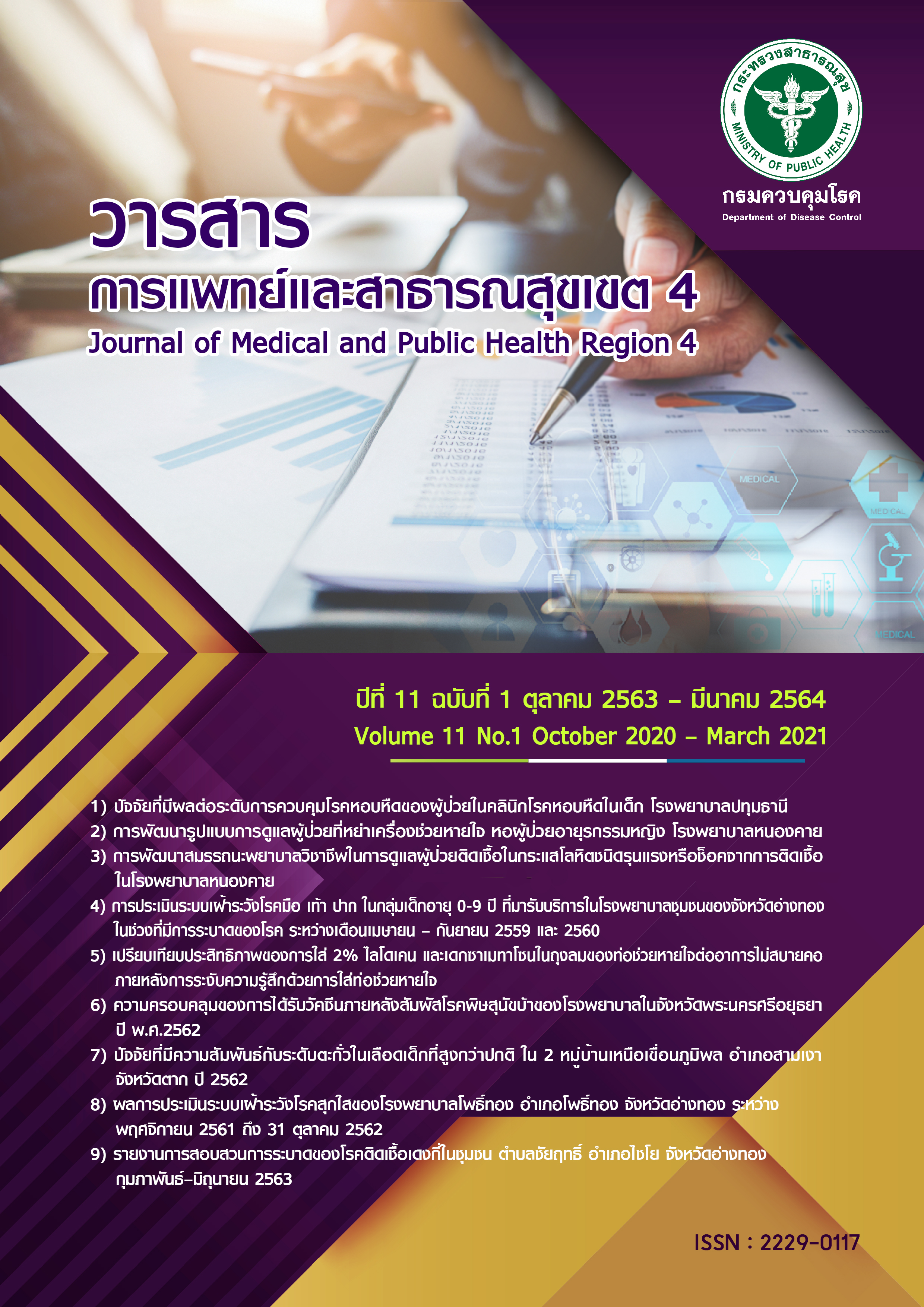Development of Patient Care Model for Patient Weaning from Mechanical Ventilator in Female-medical Ward, Nongkhai Hospital
Main Article Content
Abstract
This action research aimed to develop patient care model for patient weaning mechanical ventilator and to study the effectiveness of using the model in female-medical ward, Nongkhai Hospital. Purposive sampling were 14 nurses who work in female-medical ward and 30 mechanical ventilation patients.during 1 January 2020 – 30 April 2020. The research instruments were 1) The assessment of the readiness weaning ventilator. 2) evaluation from nurses’ opinions 3) evaluation for weaning performance of nurses.Data analysis were frequency distribution and percentage. Results: The results were as follow: The process to develop the patient Care Model for Patient weaning mechanical ventilator. It was relevant to the circumstance of the Female- medical ward Nongkhai Hospital. The Development of patient care model was feasible. The nurses expressed their opinions that the ventilator weaning model was appropriate for utilization at a high level, 85.71 %. The nurses follow the guidelines provide nursing care before removing the airway and monitor the patient’s weaning abilities and the outcome was 84.62%. For a clinical outcome achievement of ventilator weaning, the outcome was 76.67 %. The average length of stay in female medical ward was 4.70 days. Conclusion: Patient care model for patient weaning mechanical ventilator can enhance the success of weaning respirator and should be improved continually for nursing quality
Article Details
References
2. วิจิตรา กุสุมภ์, อรุณี เฮงยศมาก. การพยาบาลผู้ป่วยภาวะวิกฤต : แบบองค์รวม. อ้างใน; วิจิตรา กุสุมภ์ และคณะ พิมพ์ครั้งที่ 6. กรุงเทพฯ : ห้างหุ้นส่วนสามัญนิติบุคคล สหประชาพาณิชย์; 2560. น. 95-155
3. Blinkhorn RJ.1998. อ้างถึงใน; ปทิตตา ปานเฟืองและคณะ, ประสิทธิผลของการใช้แนวปฏิบัติในการหย่าเครื่องช่วยหายใจต่อความสำเร็จของการหย่าเครื่องช่วยหายใจและระยะเวลาในการหย่าเครื่องช่วยหายใจในผู้ป่วยวิกฤติที่ใส่เครื่องช่วยหายใจ 2558 ; หน้า 160
4. ศุภลักษ์ คูณศรี, ทวีศักดิ์ กสิผล, ดวงกมล วัตราดุลย์ , รัชนี นามจันทรา. ผลของรูปแบบการหย่าเครื่องช่วยหายใจร่วมกับแรงสนับสนุนจากครอบครัวต่อความสำเร็จ และระยะเวลาที่ใช้ในการหย่าเครื่องช่วยหายใจในผู้ป่วยที่มีภาวะการหายใจล้มเหลว. วารสารพยาบาลโรคหัวใจและทรวงอก 2558; 26(1) : 73-87
5. โรงพยาบาลหนองคาย. (2558). แบบประเมินความพร้อมผู้ป่วยเพื่อหย่าเครื่องช่วยหายใจ (weaning protocol).หนองคาย : โรงพยาบาลหนองคาย
6. ยุพา วงศ์รสไตร, อรสา พันธ์ภักดี, สุปรีดา มั่นคง. แนวปฏิบัติการพยาบาลเพื่อส่งเสริมความสำเร็จในการหย่าเครื่องช่วยหายใจ, Rama Nursing Journal.2019 ; 14(3) :347-365
7. พิกุล นันทชัยพันธ์, แบบสอบถามการประเมินประสิทธิภาพในการนำไปใช้ของแนวปฏิบัติทางคลินิก,2550 อ้างถึงใน อารีย์ ภูยาดาว, การพัฒนาแนวปฏิบัติการพยาบาลทางคลินิกเพื่อเตรียมความพร้อมผู้ดูแลผู้สูงอายุ โรคหลอดเลือดสมอง โรงพยาบาลกาฬสินธุ์ 2556 ; หน้า 69
8. อรนุช วรรณกูล. การพัฒนาแนวปฏิบัติการหย่าเครื่องช่วยหายใจในหอผู้ป่วยวิกฤติศัลยกรรม โรงพยาบาลพัทลุง. Krabi Medical Journal 2018 ; 1(2) : 1-11.
9. ธารทิพย์ วิเศษธาร, กัญจนา ปุกคำ, สมจิตร์ ยอดระบำ. การพัฒนารูปแบบการหย่าเครื่องช่วยหายใจในผู้ป่วยวิกฤตศัลยกรรม โรงพยาบาลมหาราชนครศรีธรรมราช.วารสารพยาบาลโรคหัวใจและทรวงอก 2562 ; 30(2) :176 - 192


